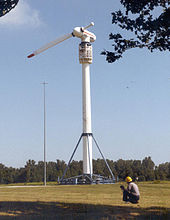Single wing (wind turbine)
Single-wing aircraft are wind turbines with only a single rotor blade . There were some projects that aimed to develop single-wing aircraft for large-scale power generation . By 2012, however, none of the projects had gotten beyond the establishment of prototypes .
Principal properties
The larger the rotors, the higher the material stress on the blades. In this respect, concentrating the material on just one sheet appears advantageous - in principle, larger systems can be built. However, a single blade causes greater tip vortex losses, which can be compensated for by a higher high-speed speed , since there are profiles with glide ratios well below 0.01. The higher speed is associated with a slimmer blade, which on the one hand negates the stability advantage and on the other hand means an economic advantage: the weight of the rotor is less than that of a three-bladed rotor. In addition, only one rotor blade has to be manufactured and assembled. Another advantage of a higher high speed is a lower torque and therefore less material required for the gearbox and generator.
The optimal speed for single-wing aircraft is 15 compared to 8 for three-winged aircraft. The efficiency drops correspondingly more clearly if it is dirty or iced up. While three-wing aircraft are often designed for high-speed numbers of only 6 or 7 for reasons of noise protection - which does not matter in the sea, however, the noise emissions of new-wing aircraft - which increase with the fifth power of speed - are the limiting criterion for their possible choice of location in the inland.
history
Monopteros
After developing the large Growian wind turbine in the 1980s, MBB began developing a larger wind turbine with a single-bladed rotor under the name Monopteros. The rotor of the Monopteros (from the Greek mónos = one and pterón = wing) was mounted on the leeward side , i.e. on the side of the tower facing away from the wind. A counterweight in the form of a relatively small metal body was used opposite the individual rotor blade.
On the test field of the German Wind Energy Institute (DEWI) , the Jade wind farm near Wilhelmshaven , three Monopteros 50 systems with a nominal output of 640 kW each were built in 1989 . Another was built in the north of Bremerhaven . The systems had a blade length of 56 m and a hub height of 60 m. The development and test operation were funded by the BMFT . The three systems near Wilhelmshaven were dismantled due to the technical deficiencies at the time.
The wind turbine in Bremerhaven suffered damage from a gust of wind because the blade deflected heavily and its tip was severed from a tether of the tower. A repair was too expensive and the system was also dismantled later. No other single-wing aircraft were installed.
From August 1988, 15 systems with 30 kW were operated in Cappel- Neufeld (district of Cuxhaven ) as part of a pilot project in the Cuxhaven wind farm . The purchase price at the time was the equivalent of 45,000 euros per piece. At the end of August 1992, the 15 turbines in the Cuxhaven wind farm began to be dismantled after four years of operation because some technical difficulties could not be solved. The systems had not provided the guaranteed service, as reported by the then operator Überlandwerk Nord-Hannover ( ÜNH ) , now EWE AG . Instead of generating 1 GWh of electricity per year, as promised, the systems were idle for almost half of the four years. The design at that time could not prevail due to the design-related strong load changes and low-frequency noise emissions .
NASA
In the late 1980s, NASA also experimented with single-blade wind turbines. However, no market-ready model has emerged from these attempts.
Further developments
Despite the problems in the past, the Spanish company ADES is trying to restart with single-wingers. A single-winged test rig was built, the nacelle of which is rigid, as the entire wind turbine rotates around a central anchor point.
Individual evidence
- ↑ Peter Jamieson: Innovation in Wind Turbine Design . Wiley, 2011, ISBN 978-0470699812 , pp. 195 f., Limited preview in Google Book Search
- ↑ Answer of the Federal Government to the minor question from the Member of Parliament Dr. Müller (Bremen) and the DIE GRÜNEN parliamentary group - printed matter 10/3638 (PDF; 478 kB) at: bundestag.de , July 10, 1985, accessed on October 27, 2012
- ↑ CBF Ensworth III, RD Corrigan, BM Berkowitz: Testing of a One-bladed 30-meter-diameter Rotor on the DOE / NASA Mod-0 Wind Turbine , National Aeronautics and Space Administration, Cleveland, OH (USA). Lewis Research Center; Sverdrup Technology, Inc., Cleveland, OH (USA), 1988
- ↑ Video about the one-wing aircraft from ADES with an output of 250 KW
- ↑ One-wing aircraft with a rigid nacelle
literature
- Patent EP0009767B1 : " Single- blade rotor for wind turbines and method for starting and stopping the same". Registered on September 27, 1979 , published on April 16, 1980 , applicant: Messerschmitt-Bölkow-Blohm, inventor: Franz-Xaver Wortmann.

